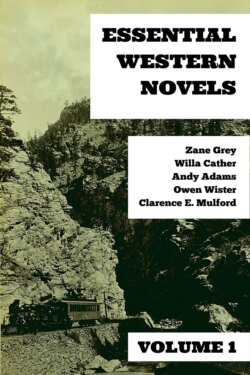Оглавление
Zane Grey. Essential Western Novels - Volume 1
Table of Contents
Introduction
The West and American Ideals
Frontier Folk
Riders of the Purple Sage
Chapter I – Lassiter
Chapter II - Cottonwoods
Chapter III – Amber Spring
Chapter IV – Deception Pass
Chapter V – The Masked Rider
Chapter VI – The Mill Wheel Of Steers
Chapter VII – The Daughter Of Withersteen
Chapter VIII - Surprise Valley
Chapter IX – Silver Spruce And Aspens
Chapter X - Love
Chapter XI – Faith And Unfaith
Chapter XII – The Invisible Hand
Chapter XIII – Solitude and Storm
Chapter XIV – West Wind
Chapter XV – Shadows On The Sage Slope
Chapter XVI - Gold
Chapter XVII – Wrangle’s Race Run
Chapter XVIII – Oldring’s Knell
Chapter XIX - Fay
Chapter XX – Lassiter’s Way
Chapter XXI – Black Star And Night
Chapter XXII – Riders Of The Purple Sage
Chapter XXIII – The Fall Of Balancing Rock
My Antonia
Book I. The Shimerdas
I
II
III
IV
V
VI
VII
VIII
IX
X
XI
XII
XIII
XIV
XV
XVI
XVII
XVIII
XIX
Book II. The Hired Girls
I
II
III
IV
V
VI
VII
VIII
IX
X
XI
XII
XIII
XIV
XV
Book III. Lena Lingard
I
II
III
IV
Book IV. The Pioneer Woman’s Story
I
II
III
IV
Book V. Cuzak’s Boys
I
II
III
The Virginian
To the reader
I. Enter the man
II. “When you call me that, smile!”
III. Steve Treats
IV. Deep into cattle land
V. Enter the woman
VI. Em'ly
VII. Through two snows
VIII. The sincere spinster
IX. The spinster meets the unknow
X. Where fancy was bred
XI. “You’re going to love me before we get through”
XII. Quality and equality
XIII. The game and the nation – act first
XIV. Between the acts
XV. The game and the nation – act second
XVI. The game and the nation – last act
XVII. Scipio moralizes
XVIII. “Would you be a parson?”
XIX. Dr. MacBride begs pardon
XX. The judge ignores particulars
XXI. In a state of sin
XXII. “What is a rustler?”
XXIII. Various points
XXIV. A letter with a moral
XXV. Progress of the lost dog
XXVI. Balaam and Pedro
XXVII. Grandmother Stark
XXVIII. No dream to wake from
XXIX. Word to Bennington
XXX. A stable on the flat
XXXI. The cottonwoods
XXXII. Superstition trail
XXXIII. The spinster loses some sleep
XXXIV. To fit her finger
XXXV. With malice aforethought
XXXVI. At Dunbarton
The Log of a Cowboy
Chapter I – Up The Trail
Chapter II – Receiving
Chapter III – The Start
Chapter IV – The Atascosa
Chapter V – A Dry Drive
Chapter VI - A Reminiscent Night
Chapter VII - The Colorado
Chapter VIII – On The Brazos And Wichita
Chapter IX – Doan’s Crossing
Chapter X – “No Man’s Land”
Chapter XI - A Boggy Ford
Chapter XII – The North Fork
Chapter XIII - Dodge
Chapter XIV – Slaughter’s Bridge
Chapter XV – The Beaver
Chapter XVI – The Republican
Chapter XVII Ogalalla
Chapter XVIII – The North Platte
Chapter XIX – Forty Islands Ford
Chapter XX - A Moonlight Drive
Chapter XXI - The Yellowstone
Chapter XXII - Our Last Camp-Fire
Chapter XXIII - Delivery
Chapter XXIV - Back To Texas
Bar-20
I
II
III
IV
V
VI
VII
VIII
IX
X
XI
XII
XIII
XIV
XIV
XVI
XVI
XVIII
XIX
XX
XXI
XXII
XXIII
XXIV
XXV
The Authors
About the Publisher
Отрывок из книги
Title Page
Introduction
.....
In this view they found allies among the labor leaders of the East, who in the same period began their fight for better conditions of the wage earner. These Locofocos were the first Americans to demand fundamental social changes for the benefit of the workers in the cities. Like the Western pioneers, they protested against monopolies and special privilege. But they also had a constructive policy, whereby society was to be kept democratic by free gifts of the public land, so that surplus labor might not bid against itself, but might find an outlet in the West. Thus to both the labor theorist and the practical pioneer, the existence of what seemed inexhaustible cheap land and unpossessed resources was the condition of democracy. In these years of the thirties and forties, Western democracy took on its distinctive form. Travelers like De Tocqueville and Harriet Martineau, came to study and to report it enthusiastically to Europe.
Side by side with this westward marching army of individualistic liberty-loving democratic backwoodsmen, went a more northern stream of pioneers, who cherished similar ideas, but added to them the desire to create new industrial centers, to build up factories, to build railroads, and to develop the country by founding cities and extending prosperity. They were ready to call upon legislatures to aid in this, by subscriptions to stock, grants of franchises, promotion of banking and internal improvements. These were the Whig followers of that other Western leader, Henry Clay, and their early strength lay in the Ohio Valley, and particularly among the well-to-do. In the South their strength was found among the aristocracy of the Cotton Kingdom.
.....
